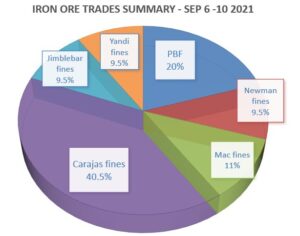A total of 840,000 mt of iron ores was traded for the week ended Sep 10, amid a series of price correction due to low steel demand.
Iron ore prices continued its corrections phrase, despite being at the traditional peak construction season. However, iron ore demand failed to gain tractions due to the extending steel output cuts spreading fast to other Chinese provinces.
During the week, the trades volume of Carajas fines accounted the largest market share at 40.5%, then followed by PBF at 20%, and Mac fines at 11% too.
High grade fines back in favour
Mills were active seeking for high grade fines such as Carajas fines, due to high coke prices, which resulted more mills to reduce coke usage and increase usage of medium and high grade fines in the blast furnace mix.
Some mills were even heard to consider using low-high grade fines combination instead of using medium grade fines for cost efficiency in blending.
However, mills with less flexible continued to see for medium grade fines like PBF, and some interests on Mac fines, as they found purchase prices attractive due to the recent corrections.
Improving margins from lower iron ore prices
The recent lower iron prices had increased Chinese blast furnace steel mills’ profitability in August, with an average margin of RMB 408/mt from rebar sales, up 37% as compared to an average margin of RMB 297/mt for July.
Some trade participants expected the better average margins to continue for September in view of the lower iron ore prices, which might undergo a few of corrections.
However, the iron ore demand was hindered by the ongoing steel output restriction extended to Shandong, Guangxi, Xinjiang and Sichuan provinces as well as the recent output cuts in the city of Handan, Hebei.
